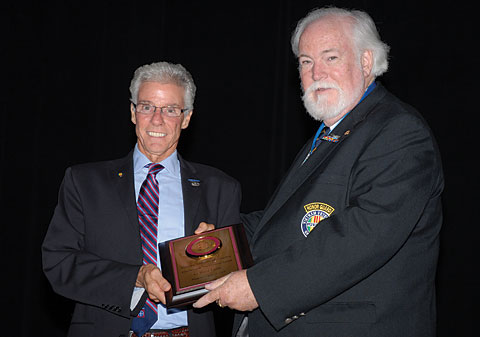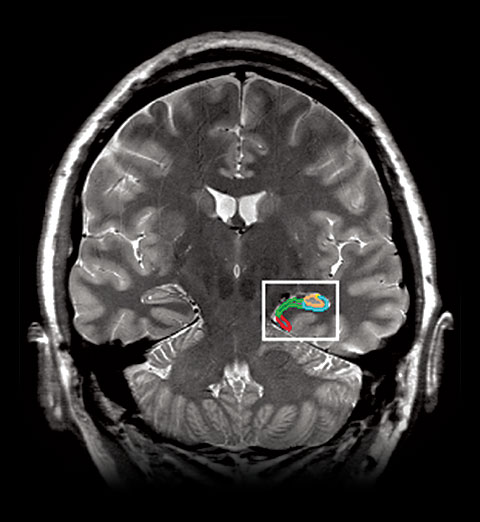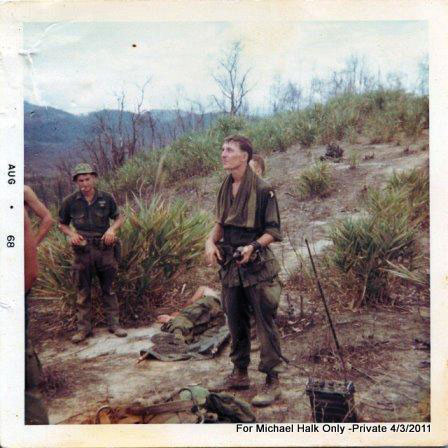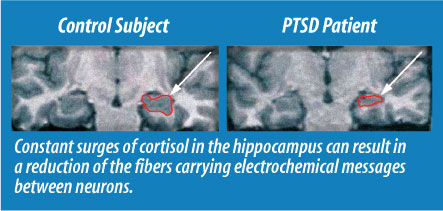 |
||||||||||||
|
September/October 2013 PTSD & Our Reptilian Brain:
BY LOANA HOYLMAN
Our ancestors had to have a system for recognizing danger, or they could not have survived. When danger comes, there is no time to think things out, to reason, to postulate. Action has to be immediate. In this oldest part of our brains, certain defenses come into play: avoidance, hypervigilance, appeasement, aggression, and escape. We can fight or we can take flight. We can also freeze and play dead. “Given that our genetic ancestors had to develop a system for the recognition of danger in order to survive,” G. Reid Lyon says, “the neural architecture that evolved did not need a frontal lobe to become activated and alert the brain to respond, hopefully in a way where you stayed alive whether you were a monkey, a mouse, or a fly.”
Concurrent with his research appointment at the VA this year Reid Lyon was a distinguished professor of leadership and policy at Southern Methodist University. He also has served as a distinguished research scholar at the Center for Brain Health at the University of Texas at Dallas. Before that, he was a branch chief at the National Institutes of Health, where he oversaw research in developmental neuroscience; cognitive, affective, and social development; behavioral pediatrics; and learning and learning disorders. Lyon has frequently testified before U.S. House and Senate committees. He served on the faculties of Northwestern University, the University of Vermont, and the University of Alabama, Birmingham, and has published eight books and more than 130 journal articles and book chapters.
“When I went to Vietnam in February 1968, I went with an entire brigade from the 82nd Airborne Division, and I served in a recon unit,” Lyon said in a recent interview. “We were thrust into combat immediately when we were deployed to Hue during Tet, and I had to learn skills very quickly that I had only been exposed to in training. “Long story short, I spent fifteen months in combat with some days better than others. I was a skinny guy, so I volunteered to go into tunnels. But one time another tunnel rat failed to respond to pulls on his rope (tied around each of us so the guys up top would know if we were moving or in danger). I went down into the tunnel with two other recon guys, Don Dittenhoffer and Charlie Severino. As we moved through the tunnel, we found that it was blocked by dirt and debris, and we dug through it. When we came to the guy we were looking for, we realized his rope had become stuck as he had turned a corner—the tunnels never went in a straight line. “Then we heard more dirt falling behind us and knew we could not go back the same way we had entered. We were isolated in a very small space several feet underground. So, we had to claw our way out straight up to the surface.
“Because I felt I was trained to do exactly what I was supposed to do and was a member of an elite combat unit, I did not feel it should bother me. But over the years, I was plagued by many memories of death and sheer terror, although my tunnel experiences were the most devastating with respect to my mental health and peace of mind. “When I left the Army, I immediately began college. I knew I wanted to understand the brain. I threw myself into my studies and went to school for ten years through graduate school and postdoctoral training. I believe I engrossed myself in education so I would not have time to think about Vietnam. “Unfortunately, when I finished school and my life became ‘less busy,’ I began to use alcohol in earnest to take me away from my terrible and haunting memories. A decade later I sought help for my need to isolate, my fear of closed places and crowds, my anger, my always being on alert, and my terrible nightmares. In a recurring one, I watched myself trying to claw out of a blocked tunnel while more dirt kept falling in. In another, my platoon leader was shot twice in the chest. When I was able to look at him, his eyes stared back.”
Although a single instance of overwhelming terror can alter the chemistry of the brain, making people more sensitive to adrenaline surges even decades later, developing PTSD from one incident is rare. But if trauma happens over and over, even if each event is not catastrophic, a person is likely to get PTSD. The brain and the body do not get to rest and recuperate between times of high alert and terror. Hypervigilance becomes a constant, even when no danger is actually present. Hypervigilance alone makes life unpleasant and sometimes terrible, constantly holding ready for the disaster that is around every corner. Hypervigilance alone can cause other problems, as every nerve, every synapse, every muscle, uses all the energy a body can produce. Because of the constant state of arousal, anger comes easily and without warning, and the ringing of a telephone causes you to jump out of your skin. You can’t fall asleep. If you do, you can’t stay asleep. Even if you sleep, you can’t rest. You are tense all the time, even if you hide it from others. All your energy goes to staying alert, and you are preoccupied with keeping flashbacks at bay—all the while trying to maintain a reasonable facade. In a dangerous situation we have little or no control over what happens in our brains. In the reptilian brain—otherwise known as the limbic system—many areas are stimulated, alerted, and activated simultaneously and instantly. The limbic system includes the hippocampus, amygdala, and hypothalamus. This is the seat of our emotions. Here also is behavior, motivation, and long-term memory. Here is where memory begins.
The more emotionally arousing the experience, the more the amygdala is activated, and the more firmly the memory will be seated. Because sensory information is being fed into the amygdala and the rest of the limbic system, all kinds of information is being registered. If you heard a certain sound right before you had a car wreck, the next time you hear that sound your brain will trigger a defensive response. This effect can be lessened over time by long-term potentiation, a complex system of fostering re-formation of signaling between neurons. Then there is the hypothalamus, a structure deep in the brain that helps the body regulate basic functions essential for survival. It controls body temperature, hunger, and thirst. Amazingly, its neurochemistry plays important roles in parenting and attachment behaviors, sexual behavior and satisfaction, sleep, anger, and aggressive behavior. It regulates the functioning of the pulse, blood pressure, breathing, and arousal in response to emotional circumstances. It releases stress hormones—such as cortisol—to alert us to instant danger and the need for survival. The hypothalamus is always working to get you back to balance, returning your brain and the rest of your body to homeostasis; that is, it tries to regulate your internal systems to keep you stable and settled. In the hippocampus we experience the spaces around us, everything that is going on: sounds, words, smells, where our feet and hands are, what is in the room or area, who is there, what is there. And it is here that we store the first steps of memory. There are further steps to make memory a part of our whole experience so that experiences are integrated into the fabric of our being. When an event happens in our lives, it is the amygdala that jump-starts the hippocampus to remember the event. The hippocampus begins to process the event into memory, along with our emotional reactions. The hippocampus has receptors to take in hormones like cortisol that initiate the flight-or-fight reaction. Stress is an everyday part of our lives, and the released hormones are meant to help us. Even if the stress is acute, usually we are still able to survive and to function. Some stress is prolonged into days, weeks, or years. In war, acute stress can occur time after time after time. Stress over long periods is more harmful to us than singular incidents. This is also true for abused children: It’s most damaging when the abuse takes place over many years. “Our bodies,” Lyon said, “were not designed to withstand chronic emotional or psychological stress.” The brain releases hormonal steroids over and over and over. High levels of cortisol, moreover, are toxic to the hippocampus and the amygdala. There is no time between events to assimilate what has happened, to absorb the biochemicals that are flooding the brain, so the brain stays on high alert—hypervigilance and hyperarousal—even years after the original trauma. The hippocampus begins to shrink. So does the amygdala. Some memories are forever fresh. Others disappear. PTSD flashbacks are events that did not become memories, as we think of the term. They are not recalls of events. They are the events come alive again. The stress hormones are released again, and they are released every time a flashback occurs, or a car backfires, or someone yells, or the telephone rings. “The constant surge of cortisol in the hippocampus can result in a reduction of the fibers that are used to carry electrochemical messages between neurons,” Lyon said. “The loss of these fibers shows up as reduced hippocampal volume as seen in neuroimaging studies. While damage due to short-term fear/stress/danger is reversible, prolonged stress produces lasting changes. “Adrenaline then stimulates the adrenal cortex (located on the adrenal glands on both kidneys), which causes it to release steroid hormones, like cortisol. There are also increases in the secretion of corticotropin-releasing factor, one of the main hormones that mobilize the body to meet an emergency. This hormone is regulated by the circuit linking the hypothalamus in the brain’s emotional center with the pituitary gland. The increased secretions alert the body for emergencies that are not there in reality.”
Cortisol is a major stress hormone. One of its purposes is to increase glucose into the bloodstream to enable the brain to better use the glucose for energy and to stimulate other chemicals that can repair tissues. Chronic stress releases cortisol incessantly. It takes glucose from the immune system, temporarily, to use in the brain’s defenses. Done too often, your immune system suffers. The long-term activation of the stress-response system—and the overexposure to cortisol and other stress hormones—can disrupt almost all your body’s processes. This puts you at increased risk of many health problems. Focusing and concentrating become extremely difficult. Nightmares are common and horrific. Becoming stressed is our bodies’ way of telling us to pay attention. Cortisol is necessary to our health. It works with adrenaline to build memories of short-term duration, “flash bulb” memories that help us remember what to stay away from. (We all have flash bulb memories, but in PTSD they become flashbacks.) Cortisol helps the liver to detoxify. It creates fight or flight, which we need, giving us bursts of energy to help us survive. It has short-term anti-inflammatory properties, reducing histamine secretion and stabilizing lysosomal membranes. Stabilization of lysosomal membranes prevents their rupture, preventing damage to healthy tissues. Lysosomes are within eukaryotic cells and contain enzymes used to break down anything that does not belong in the cell. These enzymes are so potent that, if released, they will kill the host cell. Cortisol lowers sensitivity to pain so that we can get through injury in dangerous situations and still function temporarily. It also helps, along with the hypothalamus, to maintain homeostasis in the body. Cortisol is supposed to be higher in the morning and lower at night so we can sleep. But constant stress causes cortisol to be high at night as well, keeping sleep away, no matter how tired we are. Even if we do fall asleep, too much cortisol keeps us from relaxing, and we toss and turn and awake exhausted. Self-medicating with alcohol or other drugs to alleviate some or all of these problems is common. “The veterans whom I work with at the VA Health Center have, in the main, been brought to their knees by PTSD and years of drinking or using drugs,” Lyon said. “In many cases they have lost their families, their jobs, their financial resources, and their self-respect. Keep in mind that most of the veterans are very intelligent, but PTSD and addiction are disorders that do not respect intelligence. In many cases their PTSD symptoms make working with others very difficult, and being exposed to constant triggers of combat experiences makes life difficult. Many of the vets, like I did in the past, self-medicate to escape from their pain and agony. “I know from my professional clinical training, my basic research, and my personal experiences that the brain has a remarkable capacity to heal itself. And, while certain medications are useful in reducing symptoms of PTSD and others are useful in reducing cravings for substance abuse, the brain will require new learning continually to recover from traumatic memories and addictive substances. In both cases recovery will be a lifelong process, but the quality and meaningfulness of our lives can be improved dramatically. “Traumatic memories are indelibly registered in memory systems within the brain and, at this point, cannot be erased by either medication or behavior therapy. They can, however, be treated in powerful ways by these modalities, and remarkable changes can be produced in how vets feel about themselves, their relationships with their families and others in their lives, and their productivity in the workplace.”
Lyon works with several therapies. Not all therapies work for all people. Because we are all different, what works for one may not work for another. Several therapies are used for PTSD. The main thrust of cognitive behavior therapy (CBT) is changing thinking patterns, which will decrease the effects of triggers. Mainstream CBT posits that changing maladjusted thinking will change behavior. But another branch of this therapy calls for changing a person’s connection to ill-adjusted thinking. Rather than being constricted in your relationship to a bad experience, you can become more open, more accepting, more cognizant of options in that relationship. Exposure therapy seems counterintuitive at first. You are taken back to traumatic events, to relive them, to swim in them, but it is done is a safe place with a trained therapist who guides you through visualization. By reexperiencing trauma in a controlled environment, you let go of fear and gain some control of the hypervigilance, hyperarousal, and general anxiety that threatens daily. One of the most persistent components of PTSD is avoidance. You do not want to go back to the bomb exploding or anything that sounds like it. You avoid movies, books, or discussions that have anything to do with the experiences you had around the bomb going off. You avoid certain people and situations. Your whole life can become truncated and atrophied. The therapist helps the client bring up all the emotions and memories around traumas, everything that’s been avoided. This is done in a safe, controlled environment. The next step is to break the patterns of fear, escape, and avoidance. This is done in graduated steps, not all at once. The outcome is that your life is enriched with the ability to no longer be afraid of what is no longer there. Distress will no longer be a constant companion. “I am trying to help veterans learn new ways of dealing with their demons,” Lyon said. “Our programs here are highly structured and provide vets with strategies and coping mechanisms to identify stressors, triggers, and—most importantly—strategies for changing how they respond to stressors and triggers. Veterans realize quickly that the new learning will not come from simply sharing experiences with other veterans, although that is important. Just as we had to learn new skills in the military, now we have to learn additional skills to cope with what life has provided us and continues to provide us. “If we can help vets learn and apply productive thinking and coping skills, we see significant changes in brain physiology in a healthy direction. We try to provide our vets with a new language to guide their thinking and behavior. We know language drives thought and language-driven thought changes neurochemistry, which means that neural communication changes for the better.” Lyon’s strength of being comes from his connection to fellow veterans. “It is as if I can sense their intensity and experience even before I know they fought and saw the horrors of combat,” he says. “There is some type of emotional shorthand that cuts through the social intercourse no matter how we have dealt with the demons or what we do for a living. In many cases, I see a weird wisdom and sense of depth I do not see among my non-combat age-mates. Just being in the presence of fellow veterans lifts my spirits. “PTSD keeps most people isolated and unable to function in their own societies. No one chooses to be impaired or to feel out of control, where everything is distorted in some way. People in general, and certainly people who have suffered, wish to live fully and well, to interact, to work at something that has meaning. “Veterans with PTSD still make contributions to society; in my case, through my profession. Sometimes people think we are crazed malcontents who just want handouts. We work hard, we study hard, we try to accomplish something meaningful to give back to our country and fellow vets.” Research has shown that PTSD is real, that PTSD is different from other emotional disorders, and that PTSD has a clear neurobiological footprint. The basic science—identifying microanatomy, microcircuitry, and neurotransmitter and hormone systems—has led to effective medicines that target the “fear circuits” and altered neurochemistry and have improved the lives of millions of veterans. PTSD cannot be “cured.” But therapies that were not available just a few years ago are showing astonishing promise. Some drugs help many: Paxil, Zoloft, Prozac, and others. There are therapies and drugs that give relief, where before none was possible. You can live well with PTSD. There is high hope for your life. You may always walk with a limp, but you can walk straight and tall.
|
||||||||||||
|
|
||||||||||||
8719 Colesville Road, Suite 100, Silver Spring. MD 20910 | www.vva.org | contact us |
||||||||||||










 Reid Lyon is a Vietnam veteran with post-traumatic stress disorder. He also is one of the nation’s foremost research scholars in the field of the neurobiology of PTSD. He received a Ph.D. from the University of New Mexico and works at the Lee County VA Health Center in Cape Coral, Florida, with veterans who have PTSD, traumatic brain injury, and other problems related to the stresses of war.
Reid Lyon is a Vietnam veteran with post-traumatic stress disorder. He also is one of the nation’s foremost research scholars in the field of the neurobiology of PTSD. He received a Ph.D. from the University of New Mexico and works at the Lee County VA Health Center in Cape Coral, Florida, with veterans who have PTSD, traumatic brain injury, and other problems related to the stresses of war.  “All of us were deeply traumatized by this experience, as we all felt fear that we never thought possible. It was much worse than getting shot at. I continued to scout tunnels, but I carried much more fear and apprehension with me than before. In addition, during combat experiences above ground I was within yards of friends who were shot and killed. I saw a lot of brutality and death over those fifteen months.
“All of us were deeply traumatized by this experience, as we all felt fear that we never thought possible. It was much worse than getting shot at. I continued to scout tunnels, but I carried much more fear and apprehension with me than before. In addition, during combat experiences above ground I was within yards of friends who were shot and killed. I saw a lot of brutality and death over those fifteen months. The amygdala is a tiny part of the brain that registers and communicates fear, as well as reward and other basic survival needs. We have two amygdalae: left and right. They perform a primary role in processing memory and emotional reactions. Our senses of sight, hearing, taste, smell, and touch feed information into the amygdalae, as well as other structures.
The amygdala is a tiny part of the brain that registers and communicates fear, as well as reward and other basic survival needs. We have two amygdalae: left and right. They perform a primary role in processing memory and emotional reactions. Our senses of sight, hearing, taste, smell, and touch feed information into the amygdalae, as well as other structures. 